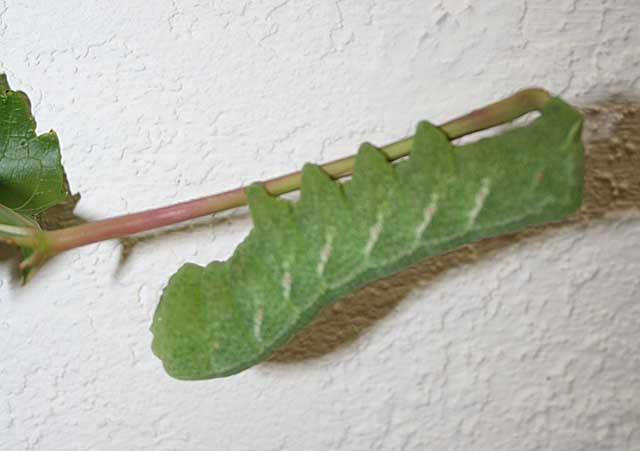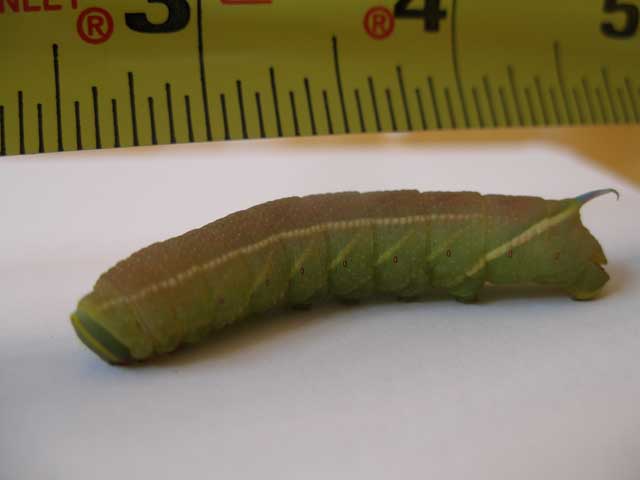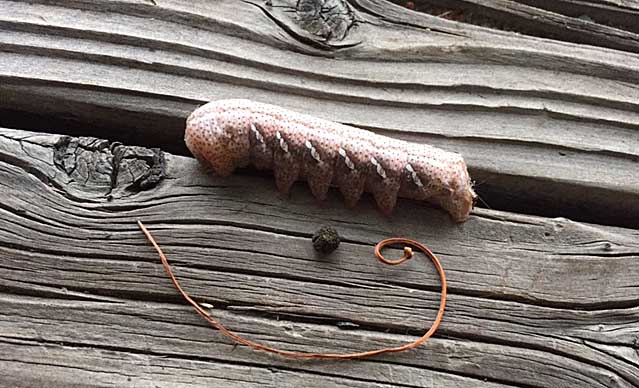Jackson County, Oregon
Sphingidae Larvae
Eumorpha achemon, Ashland, Jackson County, Oregon,
green form, August 14, 2008, courtesy of Alan J. Kelly
|
|
Created/dedicated as per personal communication with Alan J. Kelly; August 14, 2008 Updated as per James P. Tuttle's The Hawk Moths of North America, November 15, 2008 Updated as per personal communication with Michael Klam (Smerinthus opthalmica, near Howard Prairie Lake, October 2, 2011); October 2, 2011 Updated as per personal communication with Julie Futoran-Ulsted (Eumorpha achemon, Medford, July 5, 2015); July 6, 2015 |

Eumorpha achemon, Ashland, Jackson County, Oregon,
green form, August 14, 2008, courtesy of Alan J. Kelly
"My daughters would like to keep him in a terrarium. He will eat grape leaves? And we can probably just mist the leaves for a water supply? Do we need to provide sand at the bottom? Do they pupate in the air or in ground?"
Most Sphingidae larvae are encountered when they are large and mature and ready to pupate. Sometimes, however, they are just large and have some growing to do. In most cases they will do fine either in a covered aquarium or in a large glass jar (lid on tight, no airholes) or in some sort of plastic tub. Misting of the leaves is not necessary, but it is useful to let the leaves still remain on the stem and wrap the broken end of the stem in a moist paper towel. Below is a link to an article that should provide instructions for the care of most Sphinigidae larvae.
For care of "found larvae/caterpillars" visit Manduca sexta larva, central Texas, August 21, 2008, Trina Woodall.
Many thanks to Michael Klam who sends the following image of Smerinthus ophthalmica.

Smerinthus ophthalmica prepupal larva, Howard Prairie Lake, Jackson County, Oregon,
elevation 4500 feet, October 2, 2011, courtesy of Michael Klam.
Many thanks also to Julie Futoran-Ulsted who sends the following image of an Eumorpha achemon larva.

Eumorpha achemon fifth instar on grape, Medford, Jackson County, Oregon,
brown form, July 5, 2015, courtesy of Julie Futoran-Ulsted.
Only twenty-three Sphingidae species are listed for Oregon on the U.S.G.S. website. Not all of the species are reported or anticipated in Jackson County (Ten are reported on U.S.G.S. as of November 15, 2008). It is hoped that this checklist, with the thumbnails and notes, will help you quickly identify the larvae you are likely to encounter. A "WO" after the species name indicates that I have no confirmed reports of this species in your county, but I (William Oehlke) expect that this moth with its larvae are present or might be present.
A "USGS" indicates the moth is reported in Lepidoptera of North America, #1. Distribution of Silkmoths (Saturniidae) and Hawkmoths (Sphingidae) of Eastern North America, an excellent little booklet available through Paul Opler.
Please help me develop this list with improved, documented accuracy by sending sightings (species, date, location), preferably with an electronic image, via email to Bill Oehlke.
Sphinginae subfamily
Smerinthini Tribe:
Macroglossinae subfamilyDilophonotini tribe:
Philampelini tribe:
Eumorpha achemon fifth instar larva, July 5, 2015, courtesy of Julie Futoran-Ulsted
Macroglossini tribe:
|
This page is brought to you by Bill Oehlke and the WLSS. Pages are on space rented from Bizland. If you would like to become a "Patron of the Sphingidae Site", contact Bill.
Please send sightings/images to Bill. I will do my best to respond to requests for identification help.
Enjoy some of nature's wonderments: Saturniidae cocoons. Cocoons of the giant silkmoths may be purchased in the fall and winter. Big and beautiful giant silk moths will emerge in spring/summer. Read Actias luna rearing article. Additional online help available.
This website has been created and is maintained by Bill Oehlke without government or institutional financial assistance. All expenses, ie., text reference support material, webspace rental from Bizland, computer repairs/replacements, backups systems, software for image adjustments (Adobe Photoshop; L-View), ftp software, anti-virus protection, scanner, etc. are my own.
I very much appreciate all the many images that have been sent to me, or of which I have been granted permission to copy and post from other websites. All images on this site remain the property of respective photographers.
If you would like to contribute to the maintenace of this website by sending a contribution to
Bill Oehlke
Box 476
155 Peardon Road
Montague, Prince Edward Island, C0A1R0
Canada
your donation would be much appreciated and would be used for
1) paying for webspace rental;
2) paying for computer maintenance and software upgrades;
3) purchases of additional text reference material (journals and books) in anticipation of expanding the site to a worldwide Sphingidae site;
4) helping to pay my daughter's tuition (completed May 2013); with anything left over going to humanitarian aid.
If you are mailing a check from USA, please use $1.20 (2015 rate) postage. Donations can also be made through Paypal via the button below.